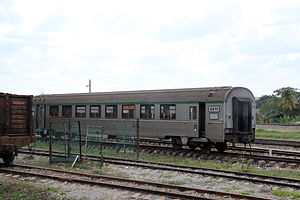Tren Francés

A coach of the Tren Francés in Las Tunas station depot
|
|||||
| Overview | |||||
|---|---|---|---|---|---|
| Service type | Inter-city rail | ||||
| Status | Operating | ||||
| Locale |
|
||||
| Current operator(s) | Ferrocarriles de Cuba | ||||
| Route | |||||
| Start | Havana | ||||
| Stops | 4 | ||||
| End | Santiago de Cuba | ||||
| Distance travelled | 854 km (531 mi) | ||||
| Average journey time | 14 hours, 45 minutes | ||||
| Service frequency | Every 3 days | ||||
| Train number(s) | 1 and 2 | ||||
| Line used | Havana-Santiago | ||||
| On-board services | |||||
| Class(es) | 1st and 2nd | ||||
| Sleeping arrangements | no | ||||
| Auto-rack arrangements | no | ||||
| Catering facilities | On-board cafeteria | ||||
| Technical | |||||
| 1 diesel locomotive (from CR) 12 ex-TEE coaches (from SNCF) |
|||||
| Track gauge | 1,435 mm (4 ft 8 1⁄2 in) | ||||
|
|||||
| Route map | |
|---|---|
 |
Tren Francés (Spanish for "French Train") is the name of the flagship Cuban InterCity service between Havana and Santiago. Owned by Ferrocarriles de Cuba, it is operated by SNCF PBA coaches originally used in Europe between Paris and Amsterdam on the ex-Trans Europ Express (TEE) Étoile du Nord service. The train is formed by 12 coaches and a Chinese-built diesel locomotive.
The Tren Francés (also spelled El Francés or Especial), named after the country of origin of the coaches (France), donated by SNCF to FFCC in 2001, is the fastest long-distance service in Cuba. It has the most modern coaches and is divided into two classes named primera especial (1st) and primera (nominally 1st, idenfitiable as 2nd). There are no sleeping cars, couchettes or car-carrying wagons.
Travelling along the Havana-Santiago line, the Tren Francés has its intermediate stops only into the main cities of Santa Clara and Camagüey. Other important cities traversed along the route are Matanzas, Colón, Ciego de Ávila, Florida, and Las Tunas. Some junction stations to nearby provincial capitals are crossed at Cabaiguán (to Sancti Spíritus) and Cacocum (to Holguín).
...
Wikipedia
